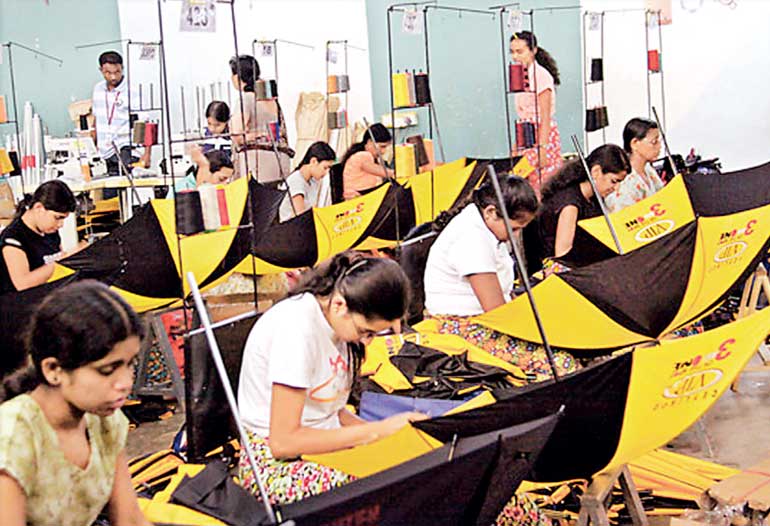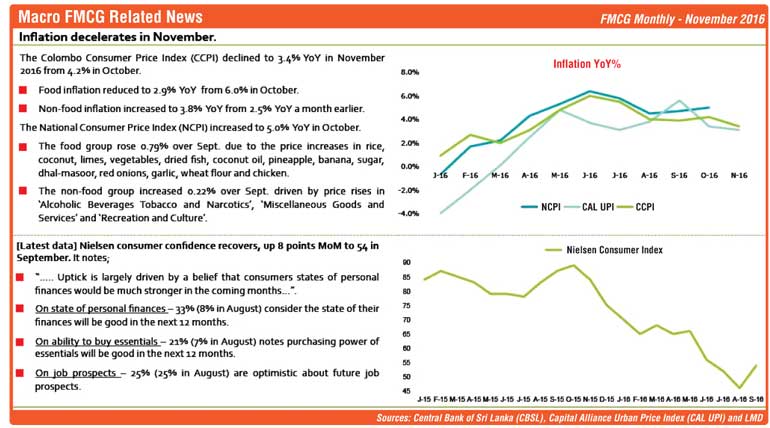Wednesday Apr 16, 2025
Wednesday Apr 16, 2025
Tuesday, 6 December 2016 00:02 - - {{hitsCtrl.values.hits}}
Top research company AC Nielsen last week announced that the Consumer Confidence Index (CCI) had picked up from a downward trend. But challenges to the consumer remain given that the economy grew by a modest 2.6% in the backdrop of the drought and floods that shocked the economy early on in the year.
Against this backdrop we see how overall trading in the country is struggling given the liquidity crunch and purchasing power challenge with the consumer price index moving 5% last month. I still remember one of my Indian bosses once stating that in tough times brilliant companies are brilliant at the basics. Let me present some of the key thoughts he shared with me that still hold ground even today.

The first thought he shared was about understanding who your core customers were. Who are the primary users of your brand that you must protect and who are the multiple brand users that shift away and to your brand? In this light, when I look at the organisation which I lead now, Lanka Sathosa, the first reality we had to face was that our primary users were households with an income of Rs. 30,000 and below that essentially comprised government servants and pensioners who live in semi-urban and rural Sri Lanka.
Against this backdrop our competitors are not other supermarket chains but more the wholesale and retail outlets in a town.
The first paradigm shift internally was to accept the target group and understand that their average bill is Rs. 600-800. Let’s love and appreciate their choice in the basket of goods. Then focus on the competitors and monitor their strategies. This year the retail brand should come close to Rs. 30 billion on top line. Strong companies are clear on segmentation and whom they target.
Given that 42% of consumers state that they have no spare cash and thus this segment is moving up by over 32% on a quarterly basis it means that the overall consumer basket will get challenged in the next few months. Given that the dollar is now hedged at Rs. 150, up from the Rs. 147 pegged for the last months, we will see that the price of essentials goods will increase further.
Namely imported items like sugar, sprats and dhal are the essential components in the Rs. 800 basket of goods. Hence we will have to devise strategies to keep the footfall going with promotions of such items with other basic products like toothpaste and Nestomalt for instance. Companies which are strong at the basics are sensitive to changes and are ready to transform. Strong companies understand consumer shifts.
This is where we must be very clear on our positioning in the marketplace and we must guard it at any cost. I remember at one of the focus group studies in my previous place of work, a traveller said that Sri Lanka as a brand was like sleeping beauty since we  had no identity globally.
had no identity globally.
When I look back its true as at one time we positioned ourselves as a beach destination. But now with focused competition from the Maldives, Mauritius and Seychelles we must carve out a clear position globally for Sri Lankan tourism. If not we will not be able to attract top-dollar tourists to the country. Strong brands are strong at the basics – have clear positioning and stay with it.
Last Sunday’s papers throw out many debates with our strong links with China and India, especially the former given the preferential land arrangements and tax concessions extended toward the Shangri-La investment at one time and now Hambantota.
Let’s accept it that customers are diverse and let’s go after the ones that bring in the most. From an investment front let’s accept that the West is poor and Brazil, Russia, India and China (BRIC) are rich and if we keep on getting traction on GDP we have to move in this manner. Let’s understand the basics and make a decision rather than relying on sentiments.
By the way, Sri Lanka’s GDP at $ 80 billion means we are smaller than companies like Apple, Pfizer and Peugeot as a brand.
The biggest debate right now in the tea industry is whether we are to drive the single origin proposition globally and command a $ 4 plus pricing for a kilogram of tea or do we import multi origin teas and get into the blended business that a consumer palate is moving towards.
Traditionalists want the former while the export sector calls for the latter to make Sri Lanka a $ 5 billion industry one day. It’s a tough decision to take but the answer relies on the basics. What is our proposition and who will pay for this unique proposition given that Sri Lanka produces around 300 million kilograms of tea while global demand is at 2.2 billion. We must get back to understanding the basics.
If we watch and read the news we can see that Sri Lanka is not spreading good news even though we are practising Yahapalanaya. Last week we saw daily protests blocking transport and attacks on public transport that went viral in the media. This comes against the backdrop of the Central Bank bond scam that sure shocked Sri Lanka and the world.
It’s time that we moved away from confrontation to understanding the basic issues and spread good news and be available for comment to the world. If we are to progress in the world of business and marketing we must develop stories that are positive and spread by people from within the country and not by global PR companies.

Let’s accept it, the export business is facing a dilemma. We will end the year at around $ 11 billion and targeting 20 billion by 2020 is almost a dream given the current supply dynamics in Sri Lanka. The views of freight forwarders will show the real picture with regard to the next few months’ exports.
It’s time that we take stock and understand who the customers we have lost are per sector and who are buying less due to the economic fallout in the West. The fact is that the UK will get hit with the BREXIT in the years to come and the US wanting to move out of the TPP after Trump coming in, influencing global trade, so Sri Lanka will have to go back to the basics and pursue regional partnerships.
The proposed partnership with India will add to driving the basics given that there are 400 million middle income households that Sri Lanka must target in 2017. Let’s go back to the basics. South Asia will grow by 8% in the years to come and we must be part of the growth agenda.
The latest trend seen globally and the new ethos is ‘whatever business one is in, it is the service business’. Rather than crying out over the issues that an investor is up against, maybe the better option would be to do a touch point study so that we can understand the ‘as is’ situation of a investor from the point one lands in Sri Lanka.
This touch point study that can be done by a specialised research agency and can help shape the key changes required based on cause and effect rather than just outcomes.
Let’s accept it that when an economy has been growing at around 4% a year in the last 30 years under war conditions, we cannot expect the administration system to run at 8% when the salary and motivation factors are the same. This means reforms have to come in and it will be painful.
The private sector must support the current Government’s agenda just like what happened in Pakistan last year. Let’s correct the basics so that Sri Lanka can be contemporary.
I saw a news release that in the case of 198 companies of the 228-odd listed organisations, the last quarter revenue drop is 17% given that the GDP grew by just 2.6%. I guess more fact-finding will have to be done so that we can understand the reasons. But becoming lean, mean and clean will have to come to play. We must accept the facts and refine business and the processes so that we can become competitive given the challenges in the environment.
Sri Lanka Tourism is targeting 2.2 million visitors this year. Whilst the numbers are moving up, a report that flashed was that only 30% of them have visited the Pinnawela Elephant Orphanage and 9% have travelled to Yala, which tells us the type of tourists that visit the country and how Sri Lanka is losing out on increasing yield per visitor.
Let’s go back to the basics and take stock of the situation and regulate our key sites for quality experiences without harming nature whilst driving up the awareness of Sri Lanka as a destination. Maybe tourism can become a $ 10 billion industry quicker.
While we recruit the best talent in developing national strategy, be it the Harvard Kennedy School or the Boston Consulting Group, what Sri Lanka essentially requires is to be brilliant at its basics. This requires the ministry’s machinery to be activated and motivated as it is here that the basics are delivered to the people.
Discover Kapruka, the leading online shopping platform in Sri Lanka, where you can conveniently send Gifts and Flowers to your loved ones for any event including Valentine ’s Day. Explore a wide range of popular Shopping Categories on Kapruka, including Toys, Groceries, Electronics, Birthday Cakes, Fruits, Chocolates, Flower Bouquets, Clothing, Watches, Lingerie, Gift Sets and Jewellery. Also if you’re interested in selling with Kapruka, Partner Central by Kapruka is the best solution to start with. Moreover, through Kapruka Global Shop, you can also enjoy the convenience of purchasing products from renowned platforms like Amazon and eBay and have them delivered to Sri Lanka.
Discover Kapruka, the leading online shopping platform in Sri Lanka, where you can conveniently send Gifts and Flowers to your loved ones for any event including Valentine ’s Day. Explore a wide range of popular Shopping Categories on Kapruka, including Toys, Groceries, Electronics, Birthday Cakes, Fruits, Chocolates, Flower Bouquets, Clothing, Watches, Lingerie, Gift Sets and Jewellery. Also if you’re interested in selling with Kapruka, Partner Central by Kapruka is the best solution to start with. Moreover, through Kapruka Global Shop, you can also enjoy the convenience of purchasing products from renowned platforms like Amazon and eBay and have them delivered to Sri Lanka.